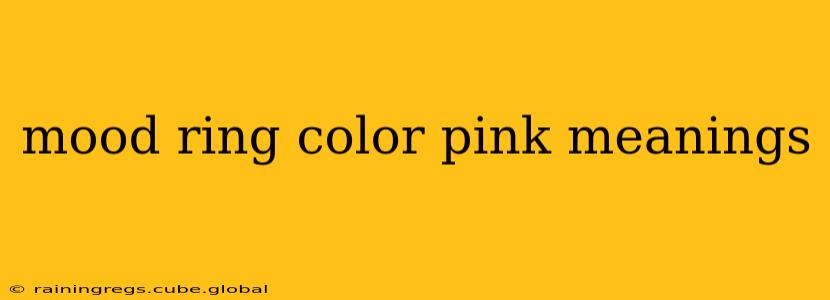Mood rings, those fascinating pieces of jewelry that supposedly reflect your emotional state through color changes, have captivated people for decades. While the science behind their color-changing capabilities is debated, the symbolic meanings associated with each color, particularly pink, remain a source of fascination. This article delves into the various shades of pink found in mood rings and explores their interpretations.
What Does a Pink Mood Ring Mean?
Generally, a pink hue on your mood ring signifies positive emotions. It's often associated with feelings of love, affection, contentment, and happiness. However, the precise meaning can vary depending on the specific shade of pink. A light, pastel pink might represent gentle affection and calmness, while a deeper, more vibrant fuchsia could indicate passionate love or intense excitement. The subtle shifts in color can offer a nuanced reading of your emotional landscape.
What are the Different Shades of Pink on a Mood Ring and Their Meanings?
The beauty of interpreting a mood ring lies in the subtleties. Different shades of pink can convey a range of emotions. Let's explore some of them:
Light Pink/Rose Pink:
This pale, delicate pink often signifies gentleness, calmness, and peace. It can suggest a relaxed state of being, free from stress or anxiety. Think of it as the emotional equivalent of a quiet, serene morning.
Hot Pink/Fuchsia:
A vibrant, bold pink like hot pink or fuchsia often points to passion, excitement, and intense energy. It might indicate a surge of strong feelings, whether romantic, creative, or simply enthusiastic. It suggests a high level of emotional arousal.
Dark Pink/Magenta:
A darker shade of pink, leaning towards magenta, might suggest a more complex emotional state. It could indicate a blend of passion and intensity combined with a touch of introspection or even a hint of underlying tension.
Are Mood Rings Accurate?
This is a frequently asked question, and the short answer is: no, not scientifically. Mood rings don't actually "read" your emotions. Their color changes are due to thermochromism – a reaction to temperature changes in your body. While your emotions can influence your body temperature slightly, the correlation isn't strong enough to provide reliable emotional readings. The interpretations are largely based on symbolic associations rather than scientific accuracy.
How Does a Mood Ring Work?
The color change in a mood ring is a result of thermochromic liquid crystals embedded within the stone. These crystals change color in response to even slight shifts in temperature. Your body temperature influences the temperature of the stone, causing the visible color change. Therefore, factors like ambient temperature, whether you've just had a hot or cold drink, or even the temperature of your skin, can all affect the color displayed.
What Other Colors Appear on Mood Rings and What Do They Mean?
While pink is a common and beloved color, mood rings display a variety of other colors, each with its own associated meaning. These generally include:
- Blue: Often associated with calmness, serenity, or sadness.
- Green: Can represent contentment, balance, or sometimes envy.
- Purple: Sometimes indicates a heightened emotional state or even confusion.
- Black: Usually associated with stress, anger, or illness.
Ultimately, the interpretation of mood ring colors is subjective and relies heavily on symbolic meaning. While they might not be scientifically accurate emotional detectors, they can be fun and intriguing ways to explore self-expression and consider emotional states. Enjoy the colorful experience and the interesting interpretations!
